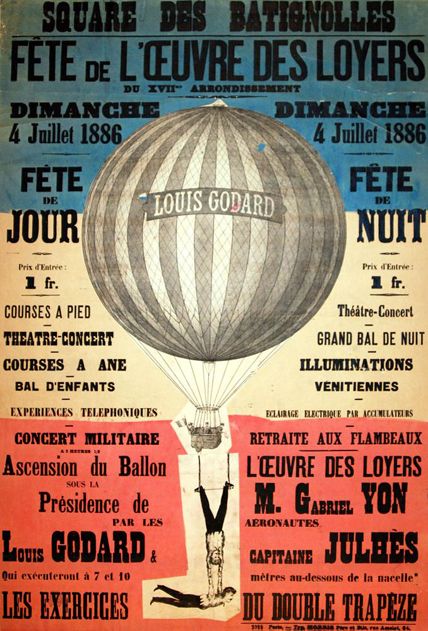Advertising Airshows
A colorful history from the National Air and Space Museum’s poster collections.

Long before the airplane, there were airshows. The very first one may have occurred in Paris on August 27, 1783, says Tom Crouch, a curator in the aeronautics department of the National Air and Space Museum. On that date, Jacques Alexandre-César Charles "flew the first small hydrogen balloon from the Champs de Mars, near the present site of the Eiffel Tower." Tickets were sold, and the public promptly went balloon-crazy. As many as 400,000 people—half the city's population—says Crouch, gathered to watch a hydrogen balloon ascend from the Jardin des Tuileries.
Pictured above: This 1886 poster publicizing a fair in the Square des Batignolles shows that 100 years later, balloons were still popular, but the public required a little something extra—in this case, a trapeze act performed by Louis Godard and Gabriel Yon.
Airplane-and-Auto Races
/https://tf-cmsv2-smithsonianmag-media.s3.amazonaws.com/filer/airplane%20and%20auto%20race.jpg)
This unusual commemorative 1912 poster doesn't offer any clues as to where the depicted airplane and auto race took place. By 1912, races between the two machines were commonplace, but the route would typically pass through several cities. This competition is a bit different in that it seems to take place on a racing track.
Flights and a Ball Game
/https://tf-cmsv2-smithsonianmag-media.s3.amazonaws.com/filer/1915%20aeroplane%20flights.jpg)
We're not sure how Curtis La Day earned the moniker "Satan." We do know that Satan was also distinguished as "The Boy Aviator," at one time the youngest licensed pilot in America. This 1915 poster features a Blériot 11 type airplane at top right, and a Wright Model B at center, while the silhouette of Gibson City, Illinois, stretches across the bottom of the print. This particular airshow offered spectators not only a variety of aircraft, but music and baseball as well.
National Air Races
:focal(327x585:328x586)/https://tf-cmsv2-smithsonianmag-media.s3.amazonaws.com/filer/National%20Air%20Races.jpg)
The National Air Races began in 1920, championed by Joseph Pulitzer as a way to promote aviation in a post-World War I economy. Various cities hosted the event over the next few years, and the races were brought to Cleveland in 1929; more than 300,000 spectators attended the 10-day affair, and the event made a profit of $90,000. (The only other venue to turn a profit—a whopping $485—was Spokane, Washington, in 1927.) Read more about Cleveland's long history with the National Air Races here. An airplane flies up and out of this 1932 poster, while other aircraft fly around racing pylons in the background.
Bevo Howard
/https://tf-cmsv2-smithsonianmag-media.s3.amazonaws.com/filer/Bevo%20Howard.jpg)
This 1951 poster from Waycross Army Air Field (part of Hunter Army Airfield in Savannah, Georgia) features the aerobatic pilot Beverly "Bevo" Howard. At 21 years of age, Howard was the youngest airline pilot in the United States. In 1941, he won a primary flight school contract from the Army Air Corps. During World War II, Howard trained more than 7,000 pilots, one-third of whom were French. He flew in his first airshow at the age of 19 and performed in more than 1,500 exhibitions. He died in an airshow crash in 1971; the Bücker Bü-133C Jungmeister he was flying was restored by his estate and donated to the National Air and Space Museum. It is now on display at the Steven F. Udvar-Hazy Center.
Rocket Belt Test Pilot
/https://tf-cmsv2-smithsonianmag-media.s3.amazonaws.com/filer/RocketBelt1.jpg)
This late 1960s poster from South Africa's Rand airshow features special guest William P. Suitor, the rocket belt test pilot for Bell Aerospace Company. The rocket belt, or jet pack, was donated to the Museum in 1973. The Museum's database notes that "The idea of the rocket belt appeared in Buck Rogers comic strips as early as 1929. Wendell Moore of Bell Aerosystems was the first to develop the invention in the mid-1950s. In the 1960s the U.S. military seriously studied the device as an aid to combat soldiers, but found its short duration of just a few seconds too limited. Today, Jet Packs are mainly used for air shows, movie stunts, or in football half-time shows and other events."
Experimental Aircraft Association
:focal(315x135:316x136)/https://tf-cmsv2-smithsonianmag-media.s3.amazonaws.com/filer/EAA.jpg)
Thousands of people—and evidently, in 1996, one cow—make the trek each year to the Experimental Aircraft Association's airshow in Oshkosh, Wisconsin. The tradition began in 1953, and has been going strong ever since. This year's airshow will be held from July 29 to August 4.